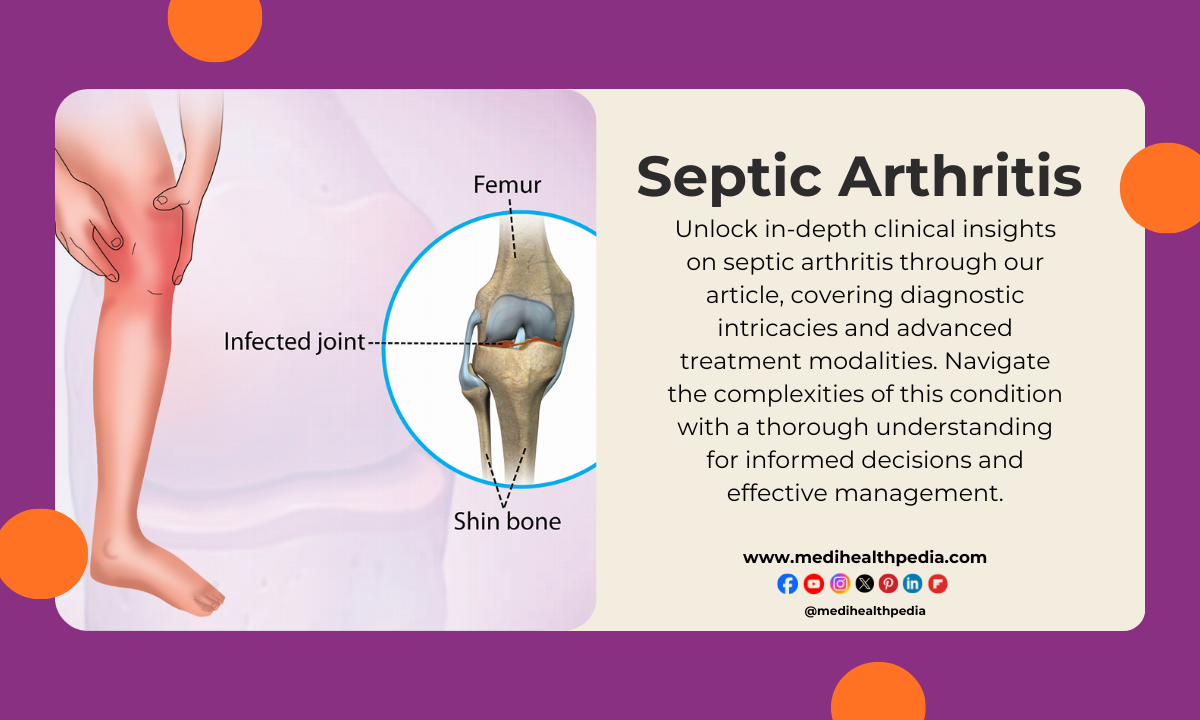Steps to Prevent Septic Arthritis: Exploring the Treatment Options for Septic Arthritis
Introduction
Septic arthritis, often referred to as infectious arthritis, is a severe and potentially life-threatening condition that affects the joints. Although it is relatively rare, septic arthritis can lead to significant joint damage and disability if not diagnosed and treated promptly. In this comprehensive article, we will delve into septic arthritis, emphasizing the importance of public awareness about this disease, covering its basic investigations, conventional treatments, prevention strategies, the role of herbal medicines, lifestyle modifications, and concluding with key takeaways to help individuals stay informed and protected.

Raising Public Awareness
Septic arthritis is not a widely recognized condition, yet its consequences can be devastating. To raise public awareness, it is essential to highlight the following key points:
- Risk Factors: Anyone can develop septic arthritis, but some groups are at higher risk. These include individuals with compromised immune systems, those with underlying joint conditions, and those who have recently undergone joint surgery or injections.
- Symptoms: Recognizing the signs of septic arthritis is crucial. Common symptoms include severe joint pain, swelling, warmth, and limited joint movement. Fever and chills may also accompany joint discomfort.
- Seeking Prompt Medical Attention: Public awareness should emphasize the importance of seeking immediate medical attention when symptoms appear. Early diagnosis and treatment are vital to prevent joint damage and complications.
- Preventative Measures: Public education should underscore the significance of preventive measures such as maintaining good joint health, practicing proper wound care, and addressing underlying medical conditions promptly.
Basic Investigations
Timely and accurate diagnosis of septic arthritis is critical to ensure effective treatment. Basic investigations include:
- Clinical Evaluation: A healthcare provider will perform a thorough clinical assessment, considering the patient’s medical history, symptoms, and risk factors.
- Joint Aspiration: A joint aspiration involves drawing fluid from the affected joint to examine its characteristics and determine the presence of infection. This is a crucial diagnostic step.
- Blood Tests: Blood tests can help identify elevated levels of inflammatory markers, such as C-reactive protein (CRP) and erythrocyte sedimentation rate (ESR), which suggest the presence of inflammation and infection.
- Imaging: X-rays and MRI scans may be used to assess joint damage and rule out other potential causes of joint pain.
Conventional Treatment
Effective treatment of septic arthritis typically involves a combination of medical approaches:
- Hospitalization: In most cases, individuals with suspected septic arthritis are admitted to the hospital for immediate treatment.
- Joint Aspiration and Analysis: Joint aspiration is often performed to diagnose the infection’s causative agent. The collected joint fluid is analyzed for the presence of bacteria or other microorganisms.
- Intravenous Antibiotics: Intravenous (IV) antibiotics are administered to treat the infection. The choice of antibiotics is determined by the identified pathogen and its sensitivity to specific drugs.
- Pain Management: Pain medications are prescribed to alleviate the often severe joint pain associated with septic arthritis.
- Joint Drainage or Surgery: In some cases, joint drainage or surgical intervention may be required to remove pus and debris from the infected joint. This can help relieve pressure and prevent joint damage.
Prevention
While not all cases of septic arthritis can be prevented, certain measures can reduce the risk:
- Good Wound Care: Properly care for wounds and injuries to prevent infections that can spread to the joints.
- Proper Joint Hygiene: If you have an underlying joint condition or have undergone joint surgery or injections, follow your healthcare provider’s instructions for care and maintenance.
- Prompt Treatment of Infections: Address infections elsewhere in the body promptly to prevent them from spreading to the joints.
- Immune Health: Maintain a strong immune system through a balanced diet, regular exercise, and adequate rest. This can help your body fight off infections more effectively.
Herbal Medicines
The role of herbal medicines in the treatment of septic arthritis is limited, and they should never replace conventional medical treatment. However, some herbs may possess anti-inflammatory and immune-boosting properties that could potentially support recovery and overall joint health. It is essential to consult with a healthcare provider before using herbal supplements, as they may interact with other medications. Here are a few herbs that may have potential benefits:
- Turmeric: Curcumin, the active compound in turmeric, has potent anti-inflammatory properties and may help reduce joint inflammation.
- Boswellia: Boswellia extract is known for its anti-inflammatory effects and has been explored as a natural remedy for joint pain.
- Ginger: Ginger has anti-inflammatory properties and may help alleviate joint discomfort.
- Echinacea: Echinacea is an herb often used to boost the immune system and may be beneficial in overall recovery.
Lifestyle Modification
Incorporating certain lifestyle changes can contribute to overall joint health and potentially reduce the risk of septic arthritis:
- Diet: Consume a balanced diet rich in anti-inflammatory foods such as fruits, vegetables, and fatty fish. These can help support your body’s natural defenses.
- Hydration: Stay well-hydrated to maintain proper joint function and overall health.
- Regular Exercise: Regular physical activity is essential for joint health and overall well-being.
- Stress Management: Chronic stress can weaken the immune system. Incorporate stress-reduction techniques such as meditation, yoga, or deep breathing exercises into your daily routine.
Conclusion
Septic arthritis is a condition that demands attention and swift action. Public awareness is a crucial first step in ensuring early diagnosis and effective treatment. By recognizing the risk factors, symptoms, and the importance of seeking immediate medical attention, individuals can better protect their joint health.
Remember that septic arthritis is a medical emergency, and any delay in seeking medical care can result in joint damage and complications. Public awareness, combined with medical intervention, prevention measures, and a holistic approach to joint health, can contribute to a safer and healthier future for all.
